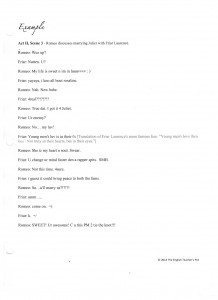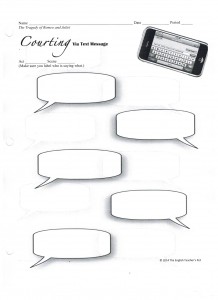Technology, cell phones, in particular, has opened a vast world of communication between individuals across a great distance. With such new forms of communications, people are always looking for new ways to say something, or type something, faster. This is where the “text messaging language” came from. People began shortening words in order to make communication faster and more efficient. In my grade 10 Applied English Literature classroom, my students were reading William Shakespeare’s Romeo and Juliet, graphic novel version. The graphic novel of the play differs greatly from the original text. While the original text is written in old English, the graphic novel is written in modern English. The language was something we focused on a great deal during reading and the concept of “lost in translation” surfaced repeatedly. I thought it would be interesting to look at how language can be refined even further, this time into text messaging language.
As a part of the modern, 21st-century classroom, students come in already well equipped with the relevant devices and the knowledge of the abbreviated language. Utilizing their knowledge was an important factor in providing them with the opportunity to think about elements of the play further. The class used the above resources as the reference. After I explained the assignment requirements, I presented the text conversation between Romeo and Friar Laurence as an example of what their conversations may look like. I also provided my students with the text-messaging template to those who did not wish to use their personal cell phones or tables in a classroom setting.
The aim of this activity was to have to the students review certain parts of the play and interpret what some characters are saying to others. While this was a fun way to engage the students in a review of past events, it also gave them an opportunity to comment on certain events and actions that took place on the play.
This was an activity to remember. Usually, students are being asked to put their cell phones away, but having an opportunity to use their cell phones for the sake of an in-class activity was something very new and exciting. By the conclusion of the activity, many students commented on the fact that much of the conversations and the meaning of the conversations was in fact lost in translation. This was a concept that I wished to discuss with my students and this activity provided me with the opportunity to do so indirectly and gave my students to realise the effects of translating a text or even simplifying it.
Example and template are courtesy of The English Teacher’s Pet (2014).

